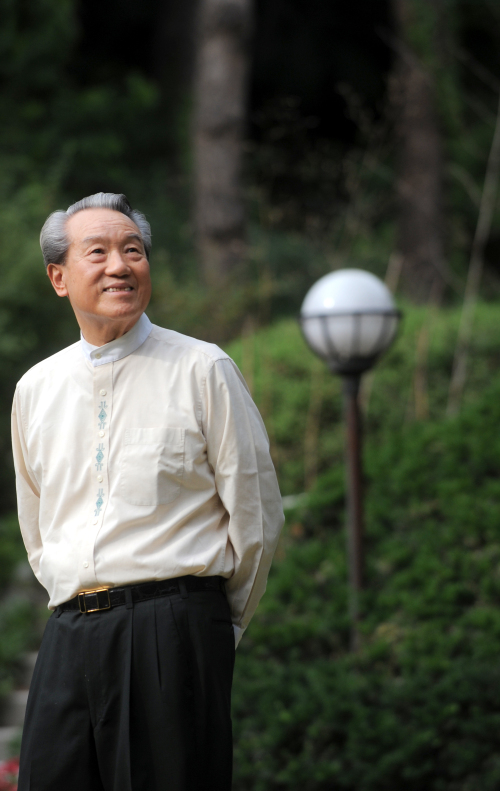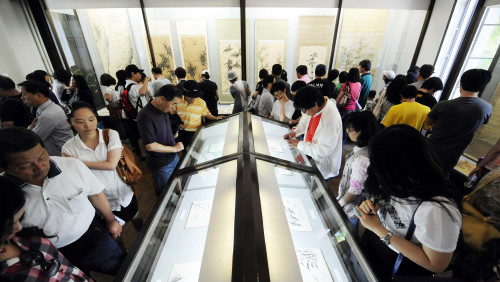The biggest crises for the museum came with the Korean War. When it broke out in June 1950, the National Treasures at the museum were sent to Busan on a freight train provided by President Syngman Rhee.
“I was a college freshman at the time and I was dispatched to guard the artifacts which were stored at a warehouse owned by a Japanese,” Chun recalls.
Meanwhile, the North Koreans wanted to take the collection to the North.
“The staff who were forcefully recruited by the North Korean military to pack the collection used all sorts of excuses to delay the move,” Chun says.
By sheer luck or perhaps the heavens helping, the North Koreans retreated from Seoul in September 1950 following the Incheon landing by U.S. General Douglas McArthur and the Kan Song collection remained in Seoul.
“We brought back the National Treasures from Busan to Seoul in 1953 as the war came to an end. A week after our departure, a great fire broke out in Busan, burning down the warehouse that we had used,” says Chun.
“I believe cultural artifacts have a fate of their own,” says Chun.
Of his father’s legacy, Chun admits that there are many things that are not comprehensible, even to a son. His father had inherited great wealth ― a recent biography estimates the land he inherited would be worth 100 billion won today ($92 million) ― and had studied law at Japan’s Waseda University. While many wealthy Korean men of his time led profligate lives indulging in wine and women, the older Chun focused his energy on collecting art.
In his collection, he was assisted by the artists and cultural figures of the highest standing of his time.
“I suppose he also had a patriotic heart,” Chun says of his father. By purchasing Korean art for large sums, he was able to save priceless cultural heritage from being taken abroad by Japanese colonialists.
The older Chun was also an avid book collector who had a bookstore on Jongno 5-ga. “When he bought a book, he would buy two to three copies. I think he was planning on opening a museum even back then. I think it was his way of providing for future students and researchers,” Chun says.
In fact, Kan Song Art Museum is unique in its emphasis on research. It was designed as a museum for researchers and the exhibitions are geared toward researchers as well, according to Chun.
While the museum is open only twice a year ― in May and October for two weeks each ― it is always open to the 50 researchers at the research institute associated with the museum.
The most recent exhibition that ended May 29 showcased 108 items depicting the “Four Gracious Plants” ― plum, orchid, chrysanthemum and bamboo ― from the 16th century to the 20th century.
“It marked the 80th exhibition and we wanted to do something we had not done in the last 40 years,” Chun explains.
The Four Gracious Plants occupy a special place in the cultural history of Korea. These were the plants that were cherished by the literati who strove to express human character and the relationship between man and nature through plants.
“The painting of the Four Gracious Plants was a must among the literati and painters. How good the paintings were determined one’s dignity, class,” Chun explains.
The biannual exhibitions are always packed with crowds ― particularly on weekends when the waiting line stretches beyond the museum compound to the street outside well before the doors open. Leisurely viewing is almost impossible, as the long line snakes around the exhibition rooms on the first and second floors.
Why not keep the museum open year-round?
“Ours is a small private museum and we have limited staff. We are also more focused on exhibitions and the research book that accompanies each exhibition,” Chun explains. “Of course, we are thinking over several things.”
The possibility of turning the private museum public does not seem to be on the Chun family’s mind.
While art insiders have raised the issue of the difficulty of preserving fragile paintings and books in a private facility, Chun maintains that the artifacts are well-preserved.
“Some experts have said that the painting scrolls should be kept hanging. However, I believe that the best way to preserve them is to keep them rolled up,” Chun says. Each scroll is rolled up, put inside a wooden box, wrapped in newspaper and put inside a metal box. The paintings are aired twice a year with the curtain drawn to protect them from direct sunlight.
“The storage room is built on a boulder which acts as a natural humidity control. Experts who came to examine the humidity level went away impressed,” Chun says.
The challenge for Chun is to keep the collection intact.
“Once a private collection is scattered, that is the end of it. In order to keep the character of the collection, it must be kept together,” Chun says.
Over the years, there have been requests to donate some of the items to the National Museum of Korea but Chun is skeptical about how often the public will be allowed to view the National Treasures there. “The ideal way to do it would be to have a separate operation for the Kan Song Collection. If this were possible, it would be a different matter. However, I think this is impossible in Korea,” Chun says.
The current museum law, with its roots dating back from the Japanese colonial era, is not appropriate for Korea, Chun claims. “The law makes it difficult to run a museum properly. It should be made more flexible,” Chun says.
“When it becomes feasible, we will undertake major repair work. Even now, we conduct repairs when necessary. We also plan to expand the storage facility,” Chun says.
“The descendents of a great man have a difficult time,” says Chun, who gave up a successful career as a painter in the U.S. and returned to Korea in 1965 following his father’s death in 1962, half-jokingly.
As for his own legacy, it would be that he has kept the collection together, upholding his father’s wish.
By Kim Hoo-ran (
khooran@heraldcorp.com)









